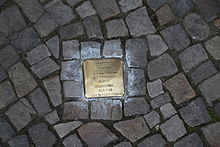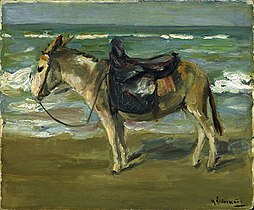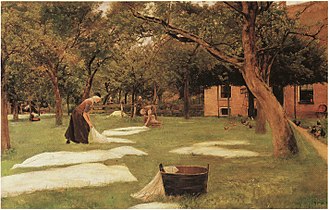Max Liebermann
Max Liebermann (20 July 1847 – 8 February 1935) was a German painter and printmaker of Ashkenazi Jewish ancestry, and one of the leading proponents of Impressionism in Germany.
막스 리버만 (Max Liebermann, 1847년 7월 20일 ~ 1935년 2월 8일) 은 독일의 화가로, 베를린 분리파 (Berliner Secession) 의 창립자 가운데 한 사람이다.〈거위털을 뜯는 여인들〉 이라는 그림으로 '추 (醜) 의 사도'라는 별명을 얻었다.
리버만은 베를린에서 유대인 사업가의 아들로 태어나, 베를린 대학교에서 법학과 철학을 공부하였으나, 뒤에 1869년 바이마르, 1872년 파리, 1876년 ~ 1877년 네덜란드에서 회화를 공부하였다. 잠시 동안 뮌헨에 거주하였으나, 1884년 베를린으로 돌아와 나머지 생애를 그 곳에서 보냈다.
리버만은 당초, 전원의 인물 및 생활 풍경 등을 그렸으며, 후에 그는 로비스 코린트 (Lovis Corinth), 막스 슬레보크트 (Max Slevogt) 와 함께 독일 인상파의 대표적 작가가 되었다. 그는 자신의 상속 재산을 프랑스 인상파 회화의 수집에 소비하였으며, 그 후 자신의 뜰 풍경 외에 부르주아지 등 부유 계급의 생활 풍경과 초상화를 그리게 돼, 독일의 미술계와 상류 사회에서 존경받는 화가가 되었다.
그는 1899년부터 1911년까지 베를린 분리파를 이끌었으며, 1920년부터 1932년까지 프로이센 예술원 원장으로 있었다. 푸르 르 메리트 훈장을 수상하고, 베를린 명예 시민에 추천되는 등, 노령임에도 불구하고, 독일 화단에서 큰 영향력을 발휘하였다.
그러나 나치가 권력을 잡은 후인 1933년, 리버만은 유대인 출신이라는 이유로 비난을 당했고, 그는 예술가가 출신이라는 정치라는 요소 때문에 비난 당하는 상태에선 예술원에 머무를 수 없다면서 명예 원장 칭호를 반납하였다. 1935년 베를린에 위치한 자신의 집에서 숨을 거뒀으며, 쇤하우저 거리에 있는 유대인 묘지에 묻혔다. [위키백과]
Biography
The son of a Jewish fabric manufacturer turned banker[1] from Berlin, Liebermann grew up in an imposing town house alongside the Brandenburg Gate.[2] He first studied law and philosophy at the University of Berlin, but later studied painting and drawing in Weimar in 1869, in Paris in 1872, and in the Netherlands in 1876–77. During the Franco-Prussian War (1870–71), Liebermann served as a medic with the Order of St. John near Metz. After living and working for some time in Munich, he finally returned to Berlin in 1884, where he remained for the rest of his life. He was married in 1884 to Martha Marckwald (1857–1943).[3][4]
He used his own inherited wealth to assemble an impressive collection of French Impressionist works. He later chose scenes of the bourgeoisie, as well as aspects of his garden near Lake Wannsee, as motifs for his paintings. In Berlin, he became a famous painter of portraits; his work is especially close in spirit to Édouard Manet. In his work he steered away from religious subject matter, with one cautionary exception being an early painting, The 12-Year-Old Jesus in the Temple With the Scholars (1879). His painting of a Semitic-looking boy Jesus conferring with Jewish scholars sparked debate.[1] At the International Art Show in Munich it stirred up a storm for its supposed blasphemy, with one critic describing Jesus as "the ugliest, most impertinent Jewish boy imaginable."[2] Noted for his portraits (he did more than 200 commissioned ones over the years, including of Albert Einstein and Paul von Hindenburg), Liebermann also painted himself from time to time.[2]
On the occasion of his 50th birthday, Liebermann was given a solo exhibition at the Prussian Academy of Arts in Berlin, and the following year he was elected to the academy.[1] From 1899 to 1911 he led the premier avant-garde formation in Germany, the Berlin Secession. In his various capacities as a leader in the artistic community, Liebermann spoke out often for the separation of art and politics. In the formulation of arts reporter and critic Grace Glueck he "pushed for the right of artists to do their own thing, unconcerned with politics or ideology".[2] His interest in French Realism was offputting to conservatives, for whom such openness suggested what they thought of as Jewish cosmopolitanism.[2] He did contribute regularly to a newspaper put out by artists during World War I.[1]
Beginning in 1920 he was president of the Prussian Academy of Arts. on his 80th birthday, in 1927, Liebermann was celebrated with a large exhibition, declared an honorary citizen of Berlin and hailed in a cover story in Berlin's leading illustrated magazine.[1] But such public accolades were short lived. In 1933 he resigned when the academy decided to no longer exhibit works by Jewish artists, before he would have been forced to do so under laws restricting the rights of Jews.[1] While watching the Nazis celebrate their victory by marching through the Brandenburg Gate, Liebermann was reported to have commented: "Ich kann gar nicht soviel fressen, wie ich kotzen möchte." ("I could not possibly eat as much as I would like to throw up.").[1]
In 1909 Liebermann bought property in Wannsee, a wealthy suburb of summer homes on the outskirts of Berlin, and designed a villa with gardens there. From the 1910s until his death, images of the gardens dominated his work.[1] Liebermann recruited also Lovis Corinth, Ernst Oppler and Max Slevogt for the Berlin Secession, together they were the most famous painters of the German Impressionism.
Liebermann died on February 8, 1935, at his home on Berlin's Pariser Platz, near the Brandenburg Gate. According to Käthe Kollwitz, he fell asleep about 7 p.m. and was gone.[5]
Although Liebermann had been famous, his death was not reported in the media, now controlled by the Nazis, and there were no representatives of the Prussian Academy of Arts or the city at his funeral in the Jewish Cemetery on Schönhauser Allee. However, despite official strictures by the Gestapo, more than 100 friends and relatives attended the funeral. Among the mourners were Kollwitz, Hans Purrmann, Otto Nagel, Ferdinand Sauerbruch, Bruno Cassirer, Georg Kolbe, Max J. Friedländer and Adolph Goldschmidt.[6]
Commemoration[edit]

In 2005/2006, the Skirball Cultural Center in Los Angeles and the Jewish Museum in New York mounted the first major museum exhibition in the United States of Liebermann's work.[2]
On 30 April 2006 the Max Liebermann Society opened a permanent museum in the Liebermann family's villa in the Wannsee district of Berlin.[7] The artist's wife, Martha Liebermann, was forced to sell the villa in 1940. on 5 March 1943, at the age of 85 and bedridden from a stroke, she was notified to get ready for deportation to Theresienstadt concentration camp.[8] Instead, she committed suicide in the family home, Haus Liebermann, hours before police arrived to take her away. There is a stolperstein for her in front of their former home by the Brandenburg Gate in Berlin.[8]
In 2011, the Israel Museum returned a painting to the Max Liebermann estate, decades after the masterpiece was looted from a Jewish museum in Nazi Germany. Liebermann had loaned his painting to the Jewish Museum in Berlin in the 1930s. The work, along with many others, disappeared from the museum during World War II.[9]
His painting Riders on the Beach was found as part of the Munich Art Hoard.[10]
Gallery
Portrait of President Paul von Hindenburg 1927
Two Riders on the Beach, 1901
'♣ 미술(美術) 마당 ♣ > - 화가[畵家]' 카테고리의 다른 글
| [독일 풍경화가]August Wilhelm Leu (0) | 2019.12.25 |
|---|---|
| [프랑스]Louis-Jean-François Lagrenée (0) | 2019.12.07 |
| [러시아]Konstantin Makovsky (0) | 2019.12.01 |
| [폴란드] 얀 마테이코[Jan Matejko] (0) | 2019.11.27 |
| [독일]Carl Eduard Ferdinand Blechen (0) | 2019.11.07 |











